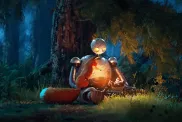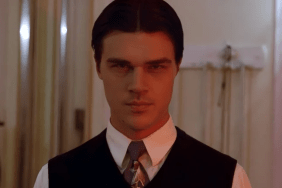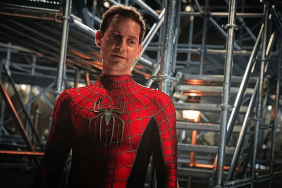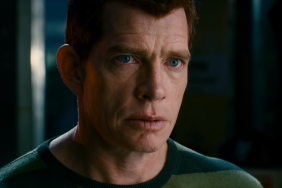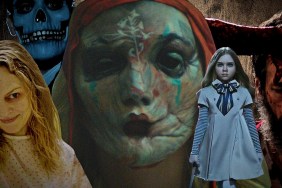The director on his latest horror opus!

There’s some bad juju in here. Alison Lohman senses it. As do the three others sitting with her at an unassuming, large wood table. The flicker of candlelight and the fragile, archaic chandeliers hanging above offer a warm glow to the room but it offers no hint as to what the unexplained presence is. “You feel the pressure is dropping,” calls out a voice from some distant dark corner of the set, “dropping…you hear a low creek and turn.” On cue, Lohman turns her blonde head, porcelain doll beauty coming into focus on the monitor this writer’s eyes are fixed upon. Her features slip into a look of anxiety and the camera pushes in slowly. Then, that commanding, yet familiar, voice again, creeping out from shadows. “It moves off…a little more frightened. The expectation.” The actress’s eyes dart around the room as the image on the monitor pitches with sluggish fluidity to the left, like a capsizing ship, into a Dutch angle.
And like that, I know I’m on the set of a Sam Raimi picture. Not a sports drama. Not a superhero blockbuster. A bonafide Raimi horror film – or, a “spook-a-blast” as he’s been overheard calling his latest effort. While a simple camera move like the one I’ve just seen might seem trivial to some, it’s a “welcome home” banner to genre aficionados accustomed to Raimi’s style. They’ve been awaiting his return to fright fare and they’re going to get it on May 29th when Universal releases the director’s Drag Me to Hell. However, that date is still a good ways off from ShockTillYouDrop.com’s set visit today on the Fox lot.
Raimi is on his 51st day of shooting and, after the aforementioned take with Lohman, he steps out of his hiding place where he was giving his star vocal cues. His team readies the next shot. Until now, the production has been shooting all over Los Angeles. The crew has since moved indoors to this soundstage where a set, that’s supposed to represent the interior of the Doheny Mansion where they had done some exterior shooting, has been built. For the purpose of the film, however, this is the home of Shaun San Dena. It’s an elaborate affair created by Steve Saklad (Raimi’s art director on Spider-Man 2) loaded with heavy drapes, ornate pillar, window and door designs and vivid walls.

San Dena (played by actress Adriana Barraza) is just one of the many characters Lohman’s Christine meets in the film as she tries to kick a curse put upon her by an old woman. Today’s scene is an important one. Christine is meeting San Dena for a séance in an effort to rid her of “the Lamia,” a demon that will send Christine’s soul to hell. She’s accompanied by a “seer,” Rham Jas (Dileep Rao), whose attempts to help her have been futile until this point. The live goat that is being escorted onto the set tells me this isn’t going to be any ordinary séance.
“I forgot how much I missed this, it’s a tremendous amount of fun,” Raimi beams. He’s not in his usual button up shirt and tie; there something more casual about his attire: Blazer, white t-shirt, glasses. Relaxed fashion for a shoot that he says has him “less panicked.”
“There are other cultures that reference the Lamia as a demon, sometimes it’s a female, a baby eater,” he continues, touching on plot’s malevolent force. “There are a lot of different stories about a demon, spirit or God known as a lamia. [Co-writer Ivan Raimi and I] read about them and were excited and interested about them. How interesting is it that this is known in different cultures and they all know that name? So we thought ‘Let’s call our creature the Lamia and take a little bit of the different ideas that are presented in these demon reference books and maybe they all have a piece of the truth.”
Drag Me to Hell‘s origins date back to 1989 when Raimi and his brother Ivan began scribbling the story down as a short. They juggled this with a script at the time that would turn into the film Darkman. Drag was ultimately fleshed out into a screenplay in the early to mid-’90s, shortly after Raimi’s Army of Darkness was released through Universal. Then something had happened that forced him to put the script on the backburner. “I started to have access to really good written material I had never been offered before,” he says. “For instance, I had a chance to read Scott Smith’s ‘A Simple Plan’ so I jumped at the chance [to direct that] and he’s a great screenwriter. After that I kept finding screenplays I really loved, Dana Stevens’ For the Love of the Game, Billy Bob Thornton wrote one called The Gift I really loved. And after that I had the opportunity to do the Spider-Man movie, I didn’t want to turn that down.”
The screenplay for Drag was revisited by Raimi in 2007 as a possible project for him to produce through Ghost House Pictures, the genre production outfit he operates with partner Rob Tapert. “This particular picture has a lot of FX in it, a lot of action in it for a horror movie,” he explains. “When I wanted to produce it, I couldn’t get the amount of money it needed with the director I [initially] had.” In the face of a looming WGA strike that could affect a drama he had intended to develop, Raimi felt Drag was ready to go with him at the helm. “It was something I really took up with great relish.”

Behind the camera, he’s joined by two vets from his Evil Dead days: Director of photography Peter Deming and KNB EFX’s Greg Nicotero. The latter has constructed a goat puppet which sits, appropriately enough, near the craft service table just a few feet away from us. Raimi radiates excitement talking about his reunion with the duo. “Peter Deming really wants to just craft the shots to build suspense and deliver a scare or to build suspense to an unexpected laugh at any moment. It’s great working with Greg Nicotero and the guys at KNB where the FX are, ‘Let’s gross them out! Let’s deliver this shock!’ It’s simpler and fun – it’s a little cruder but I’m really enjoying myself. I’m hoping the audience will enjoy it too. I’ve always enjoyed this kind of a film and I just have to think I have to do what I like, what I think is funny and what I think would be scary and hope the audience will agree with you.”
That mindset has carried Raimi since his days growing up in Michigan making short films. Decades after scaring audiences with the first Evil Dead, he admits to not knowing exactly “what works best in horror, in this case though, my brother and I wanted to write a story about a woman who, like a lot of morality tales, makes a sinful decision, she has the choice to do good or evil and ends up paying the price for it, or not, if she can escape.” He describes Drag Me to Hell as much more complex than the Evil Dead trilogy. Rooted deeper in the real world than the madcap antics of the shotgun/chainsaw-toting Ash and the Deadites. “I can honestly say this is a PG-13 picture, so it’s a little less assaultive than the Evil Dead movies which are unrated films. I don’t have any grander design or thematic ideas when making this film versus making the Evil Dead films. I’m just trying to make a horror movie that people go to, laugh at, think is suspenseful, get excited about during the monster sequences and go ‘Oh gross!’ and have those types of funhouse reactions. It’s a lower brow goal I really enjoy working in – for me it’s a great weight off my shoulders.”
Akin to his Evil Dead days, Raimi is paring back on the amount of CGI that could easily be relied on to pull off Drag‘s FX. The natural approach is the best approach in this case. “I really was introduced to CG in a major way on Spider-Man,” he says. “I had only had limited experience before because of the budget and also because Spider-Man needed that tool to pull off the illusion of the main character itself. That takes a tremendous amount of money and it’s not really my interest to work in CG. It was just the most effective tool to use to make people believe Spider-Man could exist in our world. In this film, which is much simpler film about a girl who works at a bank, makes a bad moral choice, really pisses off this old lady and gets cursed, when you hear about that, it doesn’t seem like the subject of CG, necessarily.”

Asked if he’s partial to doing smaller genre pictures over the big studio projects, Raimi answers, “I love both of them, I’m happy that I was able to return to this. I actually like making studio pictures, each has their tremendous rewards. You can have any tool you want on a big budget studio picture like Spider-Man. I turned to my d.p. today on this and said, ‘Do we have a grad filter?’ and he was like ‘No, we don’t because of expense.’ It’s just a piece of glass that makes it darker at the top and clearer at the bottom. So you’ve got to do a lot more homework in advance so you know when you need to bring out the techniques. Or you have to be able to improvise in the moment. How else can we do it?”
The director returns to set for his next scene. The séance is in full swing. Everyone around the table has joined hands. San Dena has a machete placed before her. Oh yeah, the goat is here, too. Things might not go so hot for him if he sticks around much longer. “Show yourself, Lamia!” beckons San Dena. The table centerpiece ignites in flames and the actors react as if they’re hit by a piercing sound. Raimi calls out, “Louder! It’s getting louder!” Then, “Freight train!” The camera begins to shake as if the earth beneath it is rumbling. Then San Dena is blasted with a gust of wind.
Yep, Raimi’s pulling out all of the old tricks for this one.
(For a hi-res photo gallery featuring the photos included above click here!)




Source: Ryan Rotten, Managing Editor


